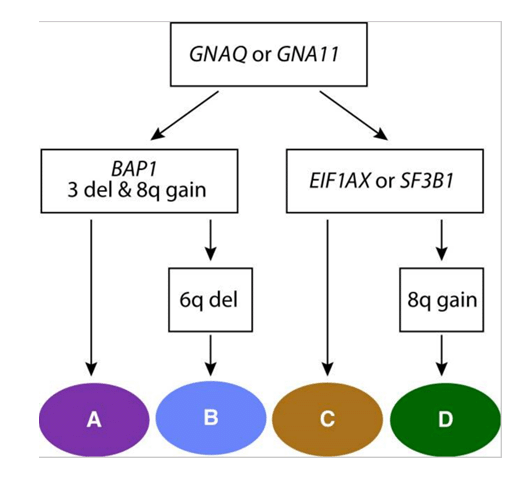
FINAL DIAGNOSIS
Genomic Alterations Identified:
DNA Mutations and Gene Fusions
Copy Number Alterations
DISCUSSION
Uveal melanoma arises from intraocular melanocytes and, while rare, it is the most common intraocular melanocytic tumor. Unlike most cutaneous melanomas, uveal melanomas have unique driver mutations (GNAQ or GNA11) and its mutational profile could be categorized to correlate with clinical outcomes. Significant genetic mutations include activating driver mutations in GNAQ or GNA11 genes followed by acquisition of BAP1 loss of function mutations or EIF1AX or SF3B1 activating mutations along with chromosomal alterations including losses of chromosome 1p, 6q, 8p, and 16q, as well as gains in 6p and 8q regions. Unlike cutaneous melanomas, uveal melanomas have a low tumor mutation burden and do not carry the ultra-violet ray mutational (C>T or CC>TT) signature.
Activating GNAQ and GNA11 mutations are mutually exclusive, involve codons 183 and 209 and found in virtually all uveal melanomas. They each encode different subunits of G-protein couple receptors ultimately involved in cell proliferation. Additional significant mutations occur in BAP1, SF3B1 and EIF1AX gene and are usually exclusive among them.
BAP1 alterations are seen in about 85% of uveal melanomas and portent a poor prognosis. BAP1 is a nuclear ubiquitin hydrolase and tumor suppressor gene, involved in cell proliferation chromatin regulation, and DNA repair. Phenotypic evidence of a BAP1 alteration was noted in this case, as BAP1 immunohistochemical protein expression was lost. High allelic frequency (81%) of BAP1 mutation compared to GNA11 mutation (43%) is due to chromosome 3p loss resulting in deletion of wild type BAP1 allele that resides within it.
Comprehensive analysis on uveal melanoma has identified four molecular distinct and clinically relevant subgroups based on the combination of DNA mutational profile and copy number alterations. Please see Figure 1.

REFERENCES
![]() Contributed by Laura Favazza, DO and Arivarasan Karunamurthy, MD
Contributed by Laura Favazza, DO and Arivarasan Karunamurthy, MD